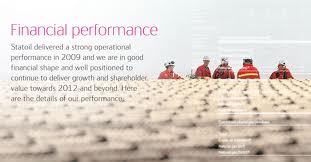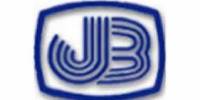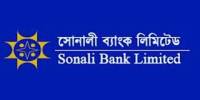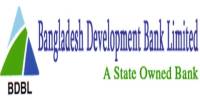The internship program is an integral part of MBA Program. I have to gather practical knowledge and skills to meet the future competition as the student of MBA Program. Without practical exposure, theory can never be fruitful. That’s why practical orientation is a positive development in professional area. In this regard, the importance of practical experience, three months practical exposure is one of the most important part of two year MBA Program. In such state of affairs the present report aiming at analyzing the experiences of practical orientation related to an appraisal of Ardent Limited.
Background of the Study
Internship program is an essential for every student, especially for the students of MBA program which helps them to know the real life situation. After completion of all the required courses of the MBA Program of BUBT, it is an indispensable part of the study to get involved in a practical professional environment for three months. Against this backdrop, I have completed my three months internship in Ardent Limited, which has helped me a lot of understand and acquired knowledge about the real life situation of the business.
I entered into an internship program at Ardent Limited and assigned topic as “Financial Performance Analysis: A Study on Ardent Limited”. While preparing this report, I had a great opportunity to have an in depth knowledge of all the financial flows of practiced by Ardent Limited. It also helped me acquire a first hand perspective of a leading enlisted company in DGDP in Bangladesh. It must be also noted that the data used here in truly and strictly confidential and no one can use its components in full or partial.
Objectives of the Study
The objective of the study case categories in two types:
(i) Broad Objective
(ii) Specific Objective
Broad Objective
The broad objective of this study is to show the “Financial Performance Analysis: A Study on Ardent Limited”.
Specific Objectives
The specific objectives of the study are as follows:
- To earn practical knowledge and experience from financial analysis
- To apply theoretical knowledge in the real situation;
- To know in detail the financial performance analysis of Ardent Limited
- To analysis the financial performance;
- To evaluate the reporting system;
- To identify and assess the impact of the present financial performance of the company;
- To focus on the weakness of financial performance of it.
- To make suggestions for further improvement of financial performance of the company.
Nature of the Study
The study will be a descriptive one and it will describe certain series of actions for the different types of activities of Ardent Limited and role of financial performance analysis. The report has prepared based on the guidance and instruction to be provided by organizational supervisors with consultation of academic supervisor.
Significance of the Study
The major motive of this study is to become familiar with the practical business world and to attain practical knowledge about the overall activities of financial performance analysis of Ardent Limited, which is so much essential for each and every student to meet the extreme growing challenges in job market. The report findings will be beneficial for the management in attempting to improve the all financial flows and also to promote the company’s services to the customers. So the study will be very useful for the top management in improving the customer satisfaction. Besides, it would be a great opportunity for me to attain practical knowledge on the various spheres of activities. So this study is very significant for both company and me.
Scope of the Study
This scope of the study has been focused on financial performance analysis of the Ardent Limited. But I have tried to concentrate on other sectors of the organization to facilitate the analysis and evaluation of the credit performance. I have been cooperated with the management of the concerned organization in each department where I have wanted to penetrate for collecting information.
Methodology of the Study
Methodology is an essential part of this study. It is designed in a way so that, it corresponds to achieve the objectives of the study. All the information incorporated in this report has been collected both from the primary sources and as well as from the secondary sources. The data classified tabulated and process in a systematic manner. In conducting this studies both qualitative and quantitative data were used. The following methodology was adopted to prepare this report.
Nature of Research
This research is descriptive in nature, and wants to know about the financial performance analysis of Ardent Limited.
Study Design
The purpose of the study is to find out the development of peoples nature, attitude, financial position, inflow, outflow of the company.
Sources of Data
The data have been collected following the two processes like as:
Primary Sources: The primary sources were including the followings:
- Face to face conversation with the respective staff and officers of the organization.
- Conversation with the customer.
- Practical work exposures from different sections of the organization.
Secondary Sources: The secondary sources were collected through the following ways:
- Annual reports of the Ardent Limited;
- The data collected from the Brochure, leaflet of the organization;
- Other relevant information have been collected directly an interview from different sections of the organization;
- Otherwise it has also taken help of some books, journals, magazine, customers and employees of the organization.
Sample Plan
Population: The population of my survey include clients, shareholders, customers and employees of the organization.
Sample Elements: The sample elements of the research are the individual, shareholders and employees of the company.
Sample Procedure: Non probability convenience sampling was used.
Ratio Analysis
Ratio analysis is the important of tools for analysis of financial performance. It is defined as the systematic use of ratio to interpret the financial statements so that strengths and weakness of a company as well as its historical performance and current financi8al condition can be determined. It refers that ratio s can be classified into four broad groups: (i) Liquidity Ratio (ii) Leverage Ratio (iii) Profitability Ratio (iv) Activity Ratio.
Trend Analysis
Trend analysis is the important analysis in ratios as well as finding their absolute levels. Trend analysis gives of a company’s financial condition is likely to improve or its decrease condition.
Data Analysis Technique
Data analysis technique is the important factor of the study. Data preparation includes the editing, coding, transcription and verification of data. Each observation form is inspected, or edited, and if, necessary, corrected. A careful and systematic data processing method has been used with the help of computer. Data has been formulated & tabulated, and finally the statistical inference & techniques has been used mainly to analyze data.
Limitations of the Study Although I have obtained whole hearted co-operation from the employees those all of the Ardent Limited but I have faced following problems on the way of my study. The problems may be limitations of my study.
Time limitation: It was tough to learning all the organization functions and preparing the internship report within just three months. So the duration that is for internship program is not enough to learn about an organization as well as its customer perception, financial analysis towards the organization like Ardent Limited.
Inadequate data: To understand the facts about the study in a realistic way and more clearly the quantitative expression of information, necessary data is required. But it was very difficult for me to collect the secondary data in all area of the study. Since it is service oriented organization, the probability of the accurate data is always low.
Fears to disclosure: It is noted that some company policies not to disclose the confidential information to the general people but the information is very much useful for preparing my internship report.
Lack of Experience: Experience makes a man efficient. But I have no proper experience to do this kind of study. So unexpired does not make this kind of study with the systematic way and apply the logical research methodology.
Lack of Record: Sufficient books, publications, fats and figures are not available. If these limitations were not been there, the report would have more useful; and attractive. There are many limitations has encountered to preparing the internship report but with constant effort, I have tried to minimize negative effects of these limitations of such study.
PROFILE OF THE ORGANIZATION
NAME OF THE ORGANIZATION
Ardent Limited
(Private Limited Company)
Head office Address:
House # 11, Road # 7 (2nd Floor)
Dhanmondi R/A, Dhaka-1205
Tel:+880 29672611-12, +880 29677331-32, Fax: +880 2 9672613
BACKGROUND
Ardent Limited is an independent private Limited company located in DhakaBangladesh, established in 2001. Our Associate Company Meditel Systems Limited established in 1993. It is one of the leading enlisted company in DGDP (Director General Defense of Purchase), CMSD (Central Medical Stores Department), BGB (Boarder Guard Bangladesh), AEC (Atomic Energy Commission). We are representing a number of principals from abroad as an exclusive distributor.
Ardent appears to have good geographic converge of Bangladesh and our experience and position in the market appear to be very much in the Medical /Diagnostic/Security field particular emphasis on equipment. Due to sophisticated logistic based on our warehouse with more than 500 products permanently available from stock you will appreciate the outstanding promptness and flexibility of our deliveries. The proprietary technologies, the experienced people working inside, the full commitment of all the components make the company reliable, flexible and ready to face challenge of the market.
MISSION
We are committed to consistent profitable growth as the means by which we establish a service industry or manufacturing industry to serve the people of our country with standard products and to promote employment for our people.
Human resources to be trained for competencies and capabilities, paying them equitable wage that will ultimately gain image and reputation for our company.
VISION
To establish the company as a prestigious organization in the country and abroad for strong identity.
OBJECTIVES
The objectives of the company are two types like as:
Financial Objectives:
- Self-funding revenue growth of 15% annually
- Increase target to 10% annually
- Increase divided per share by 5% per year
- Increase net profit margin from 5% to 10%
- A strong balance sheet.
Strategic Objectives:
- A larger market share
- Wider geographic coverage
- Attain lower overall costs
- Broader product lines
- Better sales capabilities & better customer service.
BOARD OF DIRECTORS OF ARDENT LIMITED

CORPORATE PROFILE
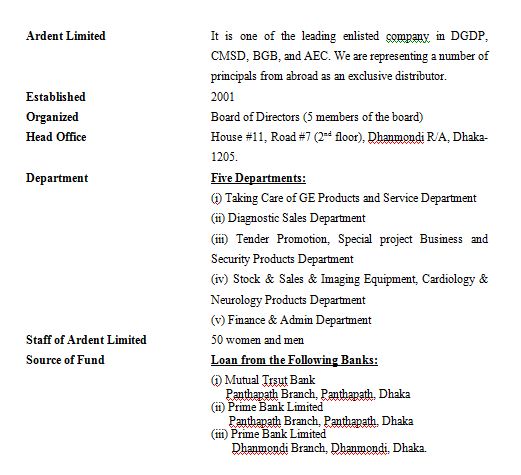 ACTIVITIES OF ARDENT LIMITED
ACTIVITIES OF ARDENT LIMITED
Ardent Limited is enlisted with the following Govt. Organization since last 7 years through Ardent and more than 10 years from Meditel:
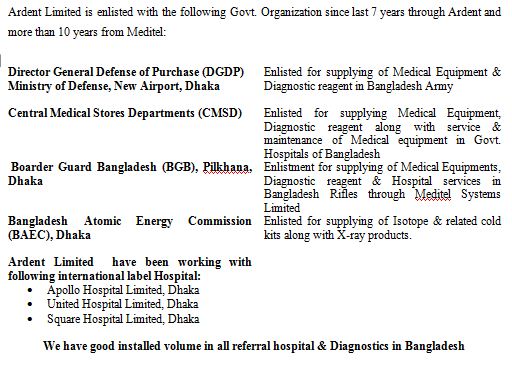
ORGANIZATION AND STAFFING
There are many staffs doing their activities in the Ardent Limited around the different departments and following details:

After Sales Service
Director
Mr. Gazi Abdur Rahman
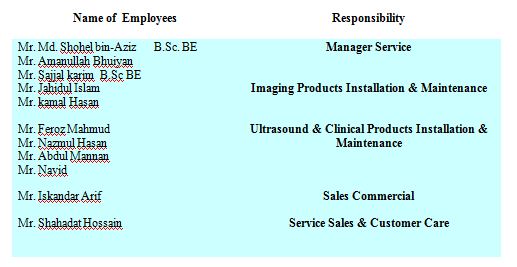
SAFETY RULES
The Ardent Limited is following the safety rules:
- Follow all care during any electrical works in all sites
- See you’re all tools are at hand during job and the tools are in proper physical condition
- While doing any electrical or installation works make sure your sho9es are on
- Take an extra while work on work and in using meters in high voltage sections
- Special attention to be made while handling heavy equipments to avoid firmly any sorts on the floor
- While on work with ladders of the floor make sure that the ladder is placed firmly on the floor
- During installation place a warning sign outside the installation site
- While traveling out of office with tool box, keep on watch for snatchers
- Working with batteries or any chemicals, be careful for any splits. In case of such splits wash the portion of the body several times with water immediately and report to doctor if any strains are visible in the skin
- In case of any injury or safety hazards call office immediately for help
FINANCIAL RULES
The following financial rules of Ardent Limited which are helping for taking financial decisions:
- All directors are to control the expenses carefully within the budget and to fulfill target.
- Unless very much necessary mid-term finance requirement can not be entertained.
- Finance Controller deputed the Board of Directors to follow the budget approved by the Board of Directors.
- All Acts, Finance & commercial activity will be controlled by the Finance Director. In case of complication Finance Director will consult with MD.
- LTR/SOD will be considered as short-term loan. Any Dept. seeks support of LTR or SOD loan should commit in writing before hand the expected time of return to the Finance Director. Finance Director will produce this to the monthly board meeting for the sanction. Unless the loans are paid back its interests to be paid monthly basis to the accts.
- All imports on cash or credit need prior approval from Finance. Approval can only be given it is satisfactorily be proved that the money required will be given after shipment.
- All credit sales need to be approved by Finance. But sales C will get approved once a month. A list of credit & cash limit is attached in annex. Company loans to be kept to a minimum in all cases. No long term loans will be allowed against company assets at the stage of the company.
- Advance taken for any purpose to be adjusted every month otherwise further advance may be refused by the accounts.
- Targets of every year will be set in the beginning of the period which to be kept in the budget & target file.
- Board of Directors may allocate more funds as per investment rules to any profit centers when sufficient reserve fund is available
- Board of Directors may use the reserve fund for emergency situations
- To cover the backlogs of previous loans, development & reserve fund can be utilized till the company liabilities are neutralized.
- Development fund to be utilized for new innovations only.
MONITORING AND EVALUATION CELL
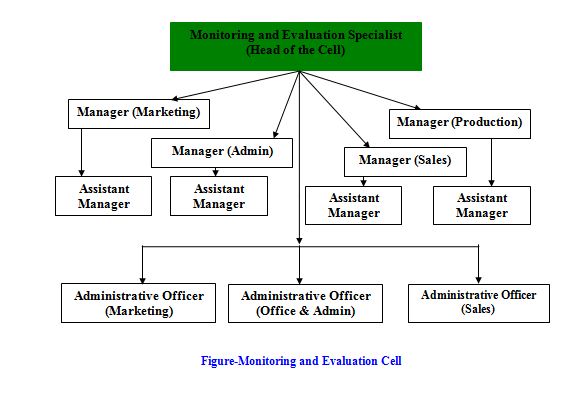 Managing Director is the specialist of monitoring and evaluation cell. The manager (sales & marketing) is informed the Managing Director about sales & marketing products and satisfaction of the customers. Assistant Manager of all departments is collected information from the different section of company. Members from M&E Cell will visit different sections and monitoring data will be collected and analyzed. Feedback will be provided on selected indicators. The M&E will use a bottom-up approach and will be carried out at four levels:
Managing Director is the specialist of monitoring and evaluation cell. The manager (sales & marketing) is informed the Managing Director about sales & marketing products and satisfaction of the customers. Assistant Manager of all departments is collected information from the different section of company. Members from M&E Cell will visit different sections and monitoring data will be collected and analyzed. Feedback will be provided on selected indicators. The M&E will use a bottom-up approach and will be carried out at four levels:
- Monitoring will be done by the respective manager responsible for the assignments;
- Assistant manager will monitor the activities of the relevant department at the field level measuring the key indicators;
- The Assistant Manager and Communication Specialist will also monitor the activities on the basis of the reports and will conduct periodic evaluations in the field level;
- The data will systematically analyze and randomly visit the different sections to any measures necessary to address quality assurance of the assignments, challenges faced, and gaps identified in an effective and time bound manner.
- In addition to these four levels of monitoring, the Team Leader, Chief Representative from Assistant Manager will monitor the overall activities for quality assurance and its proper implementation.
- Monitoring data will be collected using standardized formats which are approved by the Managing Director. The M&E Cell will compile the data and prepare reports for evaluating the company’s performance. The performance will also be evaluated through periodic in-depth interviews with the beneficiaries and those involved in the process. This reflective practice will provide insight into opportunities to improve company’s performance especially in terms of quality and coverage.
FINANCIAL ANALYSIS
A complete set of financial statements includes the following components:
BALANCE SHEET
Balance sheet consists of the assets, liabilities and the owner’s equity of a business entity. It shows financial position of the business entity. Assets and liabilities are classified as under:
(a) Current Assets: The assets that are convertible into cash in short time usually within one year without interfering with normal business operations. Currents are cash, accounts receivable, and investment in marketable securities, inventories, prepaid expenses etc.
(b) Investments: Investments are to be held for more than one year such as long-term notes fixed assets.
(c) Property, Plant and Equipments: These assets are acquired for use in the business for a long time it is one kind of fixed assets also.
(d) Intangible Assets: In such kind of assets has no physical existence such as goodwill, trade marks, patents right, copyright, legal contract and leases. Investments, Property, Plant and Equipments, Intangible assets are called the non current assets.
(e) Current Liabilities: It is just existing debits, which must be paid within one year, without interfering with normal business operations. Current liabilities are accounts payable, unearned revenue and accrued expenses.
(f) Long-term Liabilities: It is such debits that are not payable within one year, but usually payable more than one year such as Bond payable, pension obligations are the most common long term liabilities. It is also called the non current liabilities.
(g) Owner’s Equity: Owner’s equity consists of common stocks i.e. shares; additional capital paid up, and retained earnings.
INCOME STATEMENT
An income statement shows the all type of operational income and expenses including non-operating income and expenses.
STATEMENT OF CHARGES IN OWNER’S EQUITY
The statement is used to explain the effects of transactions on equity during the accounting period. It included the beginning and ending balance for the amount of contributed capital and reflects any new capital acquisitions made during the period. It also shows the portion of retained earnings retained in the business.
CASHE FLOW STATEMENT
The statement explains how a company obtained and used cash during the accounting period. The sources of cash are called cash inflow and the uses of the cash are called cash outflow. This cash flow occurs from the following three activities:
(a) Operating Activities
* Cash inflow from receives of cash from sale, commission. fees, interest and dividends.
* Cash outflow for inventories, salaries, operating expenses, interest and taxes.
(b) Investing Activities
* Cash inflow from receives of cash from the sales of property, plant, equipment, and marketable securities and from the collection of loans.
* Cash outflow for purchased of property, plant, equipment, and marketable securities and loans made to others.
(c) Financial Activities
* Cash inflow from the issue of stocks and borrowed funds from others / shareholders.
* Cash outflow for purchases of treasury stock, repayment of debit and payment of dividends
RATIO ANALYSIS
Financial ratio analysis is the calculation and comparison of ratios, which are derived from the information in a company’s financial statements. The level and historical trends of these ratios can be used to make inferences about a company’s financial condition, its operations and attractiveness as an investment. They are useful indicators of a firm’s performance and financial situation.
Financial ratios are calculated from one or more pieces of information from a company’s financial statements. Most ratios can be calculated from information provided by the financial statements. In isolation, a financial ratio is a useless piece of information. In context, however, a financial ratio can give a financial analyst an excellent picture of a company’s situation and the trends that are developing.
A ratio gains utility by comparison to other data and standards. E.g. a gross profit margin for a company of 20% is meaningless by itself. If we know that this company’s competitors have profit margins of 10%, we know that it is more profitable than its industry peers, which is quite favorable. If we also know that the historical trend is upwards, for example has been increasing steadily for the last few years, this would also be a favorable sign that management is implementing effective business policies and strategies.
Financial ratios can be classified according to the information they provide. Each category tells us about different facets of a company’s finances and operations. The following types of ratios frequently are used:
LIQUIDITY RATIO
Liquidity ratios provide information about a firm’s ability to meet its short-term financial obligations. Generally, the higher the value of the ratio, the larger the margin of safety that the company possesses to cover short-term debts. They are of particular interest to those extending short-term credit to the firm. Bankruptcy analysts and mortgage originators frequently use the liquidity ratios to determine whether a company will be able to continue as a going concern.
LEVERAGE RATIO
- These show the extent of debt used in a company’s capital structure. Any ratio used to calculate
- the financial leverage of a company to get an idea of the company’s methods of financing or to
- measure its ability to meet financial obligations. There are several different ratios, but the main
- factors looked at include debt, equity, assets and interest expenses.
EFFECUIENCY RATIO
Efficiency ratios indicate of how efficiently the firm utilizes its assets. These use turnover measures to show how efficient a company is in its operations and use of assets. They sometimes are referred to as asset turnover ratios, asset utilization ratios, or asset management ratios.
PROFITABILITY RATIO
These use margin analysis and show the return on sales and capital employed. Profitability ratios are used to determine the performance of the companies. These ratios use two sources:
- Company’s ability to recover costs and expenses using the income statement.
- The company’s ability to earn income on the assets employed using the balance sheet.
It is imperative to note the importance of the proper context for ratio analysis. A cross industry comparison of the leverage of stable utility companies and cyclical mining companies would be worse than useless. Examining a cyclical company’s profitability ratios over less than a full commodity or business cycle would fail to give an accurate long-term measure of profitability. Using historical data independent of fundamental changes in a company’s situation or prospects would predict very little about future trends.
DISUCSSION AND FINDINGS
LIQUIDITY RATIO
Liquidity ratios provide information about a firm’s ability to meet its short-term financial obligations. Generally, the higher the value of the ratio, the larger the margin of safety that the company possesses to cover short-term debts. They are of particular interest to those extending short-term credit to the firm. Bankruptcy analysts and mortgage originators frequently use the liquidity ratios to determine whether a company will be able to continue as a going concern.
CURRENT RATIO
Current ratio = Current assets / Current liabilities
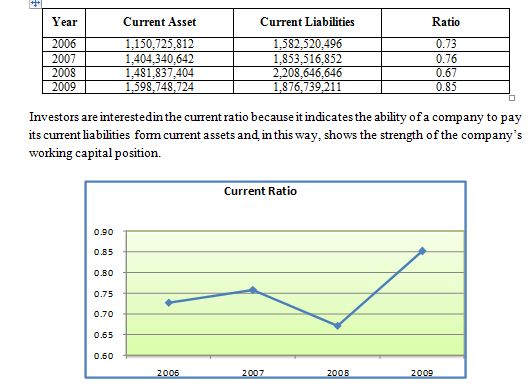 Analysis: The current ratio of Ardent Limited is relatively in a stable position, which is encouraging for the investors. From the years 2006 to 2007, current ratio has been more or less steadily increasing. The tendency of a high current ratio is a concern, because it could have been caused by idle cash, slow paying customers, and slow moving inventories. Although in 2008 current ratio has drastically reduced. We can see from the above table that current liability has been more or less not stable- but current assets have been stable.
Analysis: The current ratio of Ardent Limited is relatively in a stable position, which is encouraging for the investors. From the years 2006 to 2007, current ratio has been more or less steadily increasing. The tendency of a high current ratio is a concern, because it could have been caused by idle cash, slow paying customers, and slow moving inventories. Although in 2008 current ratio has drastically reduced. We can see from the above table that current liability has been more or less not stable- but current assets have been stable.
 Analysis: A quick glance of the above chart will show a reverse U-shaped graph for the quick ratio for the Ardent Limited. The quick ratio had been decreasing steadily until 2006-2008, mainly due to the marked decrease in quick assets. But it is increasing steadily in 2009. This can be a reason for concern since both the current ratio and the quick ratio indicate that the Ardent’s liquidity condition is more or less sound. Its current and quick asset seems to sufficient to cover its short-term obligations.
Analysis: A quick glance of the above chart will show a reverse U-shaped graph for the quick ratio for the Ardent Limited. The quick ratio had been decreasing steadily until 2006-2008, mainly due to the marked decrease in quick assets. But it is increasing steadily in 2009. This can be a reason for concern since both the current ratio and the quick ratio indicate that the Ardent’s liquidity condition is more or less sound. Its current and quick asset seems to sufficient to cover its short-term obligations.
CASH RATIO
Cash ratio = (Cash + short-term securities) / Current liabilities
 Analysis: The cash ratio rose sharply in 2008-2009. We can see that Ardent has a problem with managing its cash- and this is probably the reason for its recent decline in other liquidity ratios. It may not be a source of concern if Ardent Limited has can borrow cash on short notice- and it probably can.
Analysis: The cash ratio rose sharply in 2008-2009. We can see that Ardent has a problem with managing its cash- and this is probably the reason for its recent decline in other liquidity ratios. It may not be a source of concern if Ardent Limited has can borrow cash on short notice- and it probably can.
ACCOUNTS PAYABLE TURNOVER RATIO
Total supplier purchases / Average accounts payable
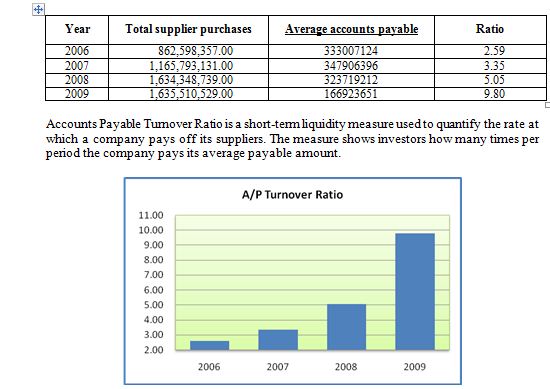
Analysis: We can see that for Ardent, the accounts payable turnover ratio has been falling for the past 3 years, with a slight increase in the last year 2009. The falling turnover ratio is a sign that the company is taking longer to pay off its suppliers than it was before. Thus in the last year, Ardent paid off its supplier faster than before. A lot of cash was paid to suppliers, which reduced cash more than current liabilities reduced- perhaps because of penalties for previous delays.
PROFITABILITY RATIOS
These show the extent of debt used in a company’s capital structure. Any ratio used to calculate the financial leverage of a company to get an idea of the company’s methods of financing or to measure its ability to meet financial obligations. There are several different ratios, but the main factors looked at include debt, equity, assets and interest expenses.
NET PROFIT MARGIN RATIO
Net Profit Margin Ratio =Net Income/ Sales
 Analysis: We can see that, from the year 2006, the net profit margin of Ardent was increasing, then after reaching the peak the margin again came down in 2007-2009. But the encouraging part for the investors is that the increase or decrease of percentage has been minimal over the years; as result we can say the NPM has been steady for the last 4 years. This is a very positive sign for the company, although the reason for decline should be investigated.
Analysis: We can see that, from the year 2006, the net profit margin of Ardent was increasing, then after reaching the peak the margin again came down in 2007-2009. But the encouraging part for the investors is that the increase or decrease of percentage has been minimal over the years; as result we can say the NPM has been steady for the last 4 years. This is a very positive sign for the company, although the reason for decline should be investigated.
OPERATING PROFIT MARGIN
Operating Profit Margin= (Net Income+ Interest) /Sales
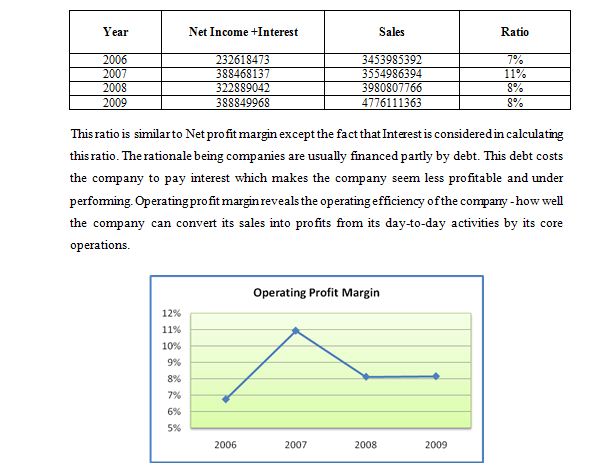 Analysis: Ardent Limited has reasonable amounts of debt over the years, but this interest payment doesn’t hamper the consistency of the performance of the company. Like the Net operating margin, Ardent’s Operating profit margin is pretty consistent and impressive for the investors and creditors. The two profitability ratios show similar trend lie over the years. This indicates that interest expenses has been steady over the years, and is not too much of a worry. Although like Net Profit Margin, reason for decline in the margin in 2008-2009 needs to found.
Analysis: Ardent Limited has reasonable amounts of debt over the years, but this interest payment doesn’t hamper the consistency of the performance of the company. Like the Net operating margin, Ardent’s Operating profit margin is pretty consistent and impressive for the investors and creditors. The two profitability ratios show similar trend lie over the years. This indicates that interest expenses has been steady over the years, and is not too much of a worry. Although like Net Profit Margin, reason for decline in the margin in 2008-2009 needs to found.
RETURN ON ASSETS
Return on Assets = (Net Income +Interest)/Average Total assets
 Analysis: In Ardent, this ratio has been pretty attractive for the last five years. The percentage has been hovering around 9%, which is quite impressive for any venture. But, in the recent time (2007), there has been a decline of around 4%, which should be carefully observed by the investors and creditors. This has been the case of all profitability ratios, and probably due to some external or internal conditions- which may have been remedied, since the margin has picked up in the following year.
Analysis: In Ardent, this ratio has been pretty attractive for the last five years. The percentage has been hovering around 9%, which is quite impressive for any venture. But, in the recent time (2007), there has been a decline of around 4%, which should be carefully observed by the investors and creditors. This has been the case of all profitability ratios, and probably due to some external or internal conditions- which may have been remedied, since the margin has picked up in the following year.
RETURN ON EQUITY
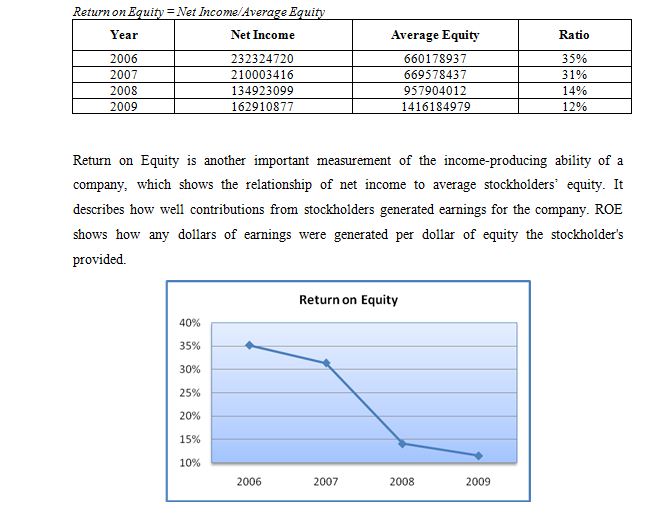 Analysis: Potential investors in Ardent Limited should be cautious about the decrease in the rate of return on equity from 2007 to 2009.Return on Equity has been slumped almost by 17% in this time. This has been the case of all profitability ratios, and probably due to some external or internal conditions-which although for other ratios had picked up like the ROA, but for ROE it has further fallen in 2008-2009. This is a significant reason for concern and caution.
Analysis: Potential investors in Ardent Limited should be cautious about the decrease in the rate of return on equity from 2007 to 2009.Return on Equity has been slumped almost by 17% in this time. This has been the case of all profitability ratios, and probably due to some external or internal conditions-which although for other ratios had picked up like the ROA, but for ROE it has further fallen in 2008-2009. This is a significant reason for concern and caution.
EFFICIENCY RATIOS
Efficiency ratios indicate of how efficiently the firm utilizes its assets. These use turnover measures to show how efficient a company is in its operations and use of assets. They sometimes are referred to as asset turnover ratios, asset utilization ratios, or asset management ratios.
TOTAL ASSET TURNOVER
 Analysis: The above graph shows that the asset turnover for Ardent has steady trend, with the ratio rising one year more to the next year. But last year ratio rising go down. Thus Ardent is failing to utilize its assets fully to generate sales. This is probably due to increase in size of total assets, but failure to generate compensating sales from it.
Analysis: The above graph shows that the asset turnover for Ardent has steady trend, with the ratio rising one year more to the next year. But last year ratio rising go down. Thus Ardent is failing to utilize its assets fully to generate sales. This is probably due to increase in size of total assets, but failure to generate compensating sales from it.
ACCOUNT RECEIVABLES TURNOVER
Account Receivables Turnover= Sales / Average receivables
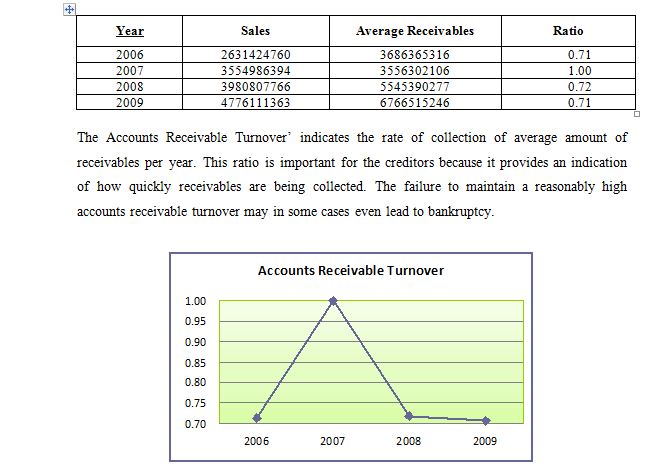
Analysis: The accounts receivable turnover for Ardent Limited as seen from the past few years is gradually declining. This corresponds with the previous finding of increasing average collection period. This can be significant reason for concern, since this signifies that Ardent is taking longer to get full payment for sales. This may mean a deteriorating cash flow situation, and even though paper profits are being shown on accounts, actual monetary condition may be quite poor.
INVENTORY TURNOVER
Inventory Turnover= C.G.S/Average Inventory.

Analysis: Over the past four years Ardent Limited has been able to maintain an inventory turnover to encourage positive financing by creditors, but the gradual increase over the four years will be a subject of scrutiny from conscious creditors. This is probably due to the increase in inventory seen in the previous analysis, and may be problematic in future.
SALES TO NET WORKING CAPITAL
Sales to net working capital = Sales / Average net working capital
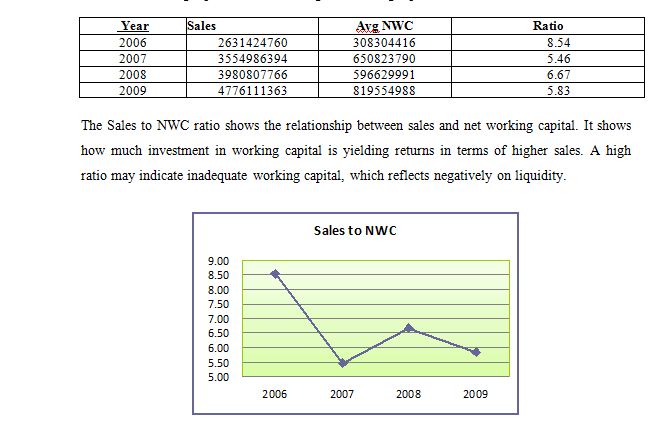 Analysis: Ardent Limited has had a relatively stable ratio in this case. They are generating more or less same level of sales each year from their investments in the net working capital. This is because investments in assets and sales are increasing at the same rate.
Analysis: Ardent Limited has had a relatively stable ratio in this case. They are generating more or less same level of sales each year from their investments in the net working capital. This is because investments in assets and sales are increasing at the same rate.
FIXED ASSET TURNOVER
Fixed Asset Turnover= Sales/ Net Fixed Assets
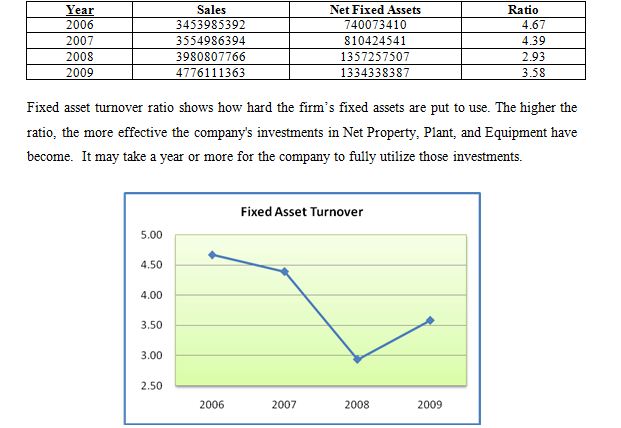
Analysis: Ardent Limited has a high fixed asset turnover, which is relatively steady other than the dip in 2006. This was probably due to increase in investment in fixed assets that year. Although the increase didn’t produce significant returns that year, the effects of it could be seen in later years-with gradually increasing fixed asset turnover.
LEVERAGE RATIOS
These use margin analysis and show the return on sales and capital employed. Profitability ratios are used to determine the performance of the companies. These ratios use two sources:
- Company’s ability to recover costs and expenses using the income statement.
- The company’s ability to earn income on the assets employed using the balance sheet.
TOTAL DEBT RATIO
Total Debt Ratio=Total Liabilities/Total Assets
 Analysis: The above chart shows that debt asset ratio for Ardent Limited has remained relatively stable over the 4-year period. It reaches its peak in 2008 and 2009 at 1.00 and 1.00 respectively and is at its lowest during 2006 and 2007 at 0.837 and 0.837 respectably. All the
Analysis: The above chart shows that debt asset ratio for Ardent Limited has remained relatively stable over the 4-year period. It reaches its peak in 2008 and 2009 at 1.00 and 1.00 respectively and is at its lowest during 2006 and 2007 at 0.837 and 0.837 respectably. All the
ratios are not under 0.5, which indicates that majority of the company’s assets, were acquired using funds from selling stock and other equity capital. The industrial trend line remained rather static. Throughout, Ardent Limited ratio is above the average trend line proving that on general, the competitors in the industry rely more on equity capital to finance assets.
ASSET TO EQUITY RATIO
Asset to Equity Ratio=Total Asset/Owners’ Equity

Analysis: The asset to equity ratio for Ardent Limited has been relatively stable over last 4 years. There was a fall in 2009 to 3.65 but it picked up & reached its peak in 2008 to 4.76. The low ratio indicates that most of its assets has been financed internally or thorough the issue of shares. The shareholders have more control and share of the assets.
CASH COVERAGE RATIO
Cash Coverage Ratio=(EBIT+ Depreciation)/Interest Payments
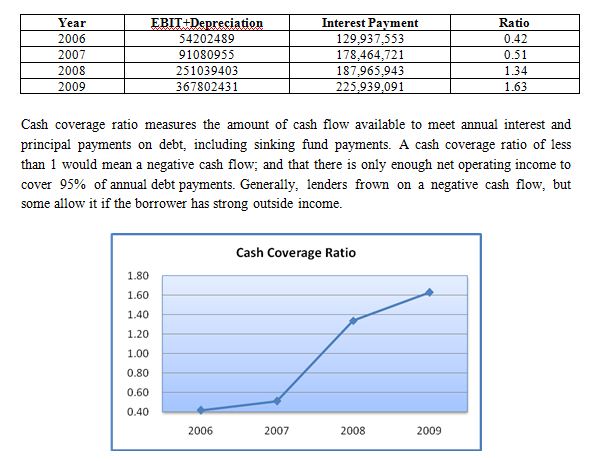
Analysis: The cash coverage ratio or Ardent Limited has been fluctuating over the last 4 years. From there it saw an increasing trend till 2009 when it reached its peak at 1.63. However the overall cash coverage ratio has been significantly high accept 2006 and 2007. This means that Ardent Limited has enough cash to settle their debts when they fall due. Ardent Limited will be able repay its liabilities from cash generated from operating activities without having to liquidate the assets used in operations. It also means that are able to make their interest payments on time.
RETAINED EARNINGS TO TOTAL ASSETS RATIO
Retained Earnings to Total Assets = Retained Earnings / Total Assets
 This ratio indicates the extent to which assets have been paid for by company profits and also measures the company’s ability to accumulate earnings using its Total Assets. Retained earnings to total assets ratio near 1:1 (100%) indicates that growth has been financed through profits not increased debt. A low ratio indicates that growth may not be sustainable as it is financed from increasing debt, instead of reinvesting profits. High or increasing retained earnings to total assets ratio is usually a positive sign, showing the company is able to continually retain increasingly more earnings. As a company grows and matures, this ratio increases
This ratio indicates the extent to which assets have been paid for by company profits and also measures the company’s ability to accumulate earnings using its Total Assets. Retained earnings to total assets ratio near 1:1 (100%) indicates that growth has been financed through profits not increased debt. A low ratio indicates that growth may not be sustainable as it is financed from increasing debt, instead of reinvesting profits. High or increasing retained earnings to total assets ratio is usually a positive sign, showing the company is able to continually retain increasingly more earnings. As a company grows and matures, this ratio increases
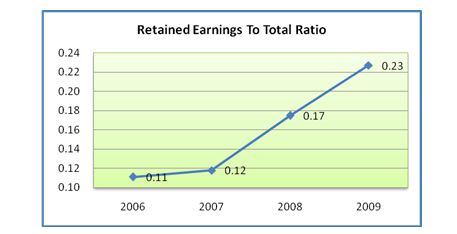
The Retained earnings to total assets ratio of Ardent Limited has seen a rising trend in the whole four years. Onwards it has kept increasing reaching it highest in 2009 at 0.23. This increasing pattern shows that retained earnings have increased steadily over the years and most of it has been used in the financing of assets. This was also evident from the long term debt
ratio and total debt ratio that Ardent Limited is more dependent on internal sources of financing rather through debt financing.
TREND ANALYSIS
Trend analysis is used to compare financial information over time to a base year. This is done selecting a base year and then assigning a weight of 100 % to the amounts appearing on the base-year financial statements. The corresponding amounts shown on the other years’ financial statements are expressed as a percentage of base-year or period amounts. Trend analysis indicates changes that are taking place in an organization and highlights the direction of these changes. In the following analysis the year 2006 has been taken as the base year.
The table above shows the trend variations in the income statement of Ardent Limited for four years, taking 2006 as the base year. Therefore in 2006 all items have been assigned a value of 100% and each item in the remaining years items have been expressed as a percentage of the consequent base.
The table shows that both net turnover and gross profit has been increasing over the period. The cost of goods sold has also been rising, but this had no significant effect on the income from operations, because net profit from operation also has a rising trend. Income from other sources has declined drastically in the last year. In fact income from other sources has been fluctuating over the time period. Net profit before tax is increasing with time. The overall income statement analysis reflects a healthy scenario for Ardent Limited with all the significant items showing a rising trend except other income.
TREND ANALYSIS OF BALANCE SHEETS
The current assets and the fixed assets the companies have increased over the years and this trend may follow through in to the years to come. Total current assets of the company have increased at a steady rate and so has the fixed assets. The trend of the current liabilities of the company has been increasing for the four years. The growth in current liability has however been followed by a good growth in current assets. On the other hand the long-term liabilities of Ardent Limited have also been increasing. In fact it has increased drastically in the period 2006-2009.
The shareholders equity has also increased over the three years. The reserves and surpluses however have experienced a healthy growth, which means that more is now distributable to the same number of shareholders. As the assets increase, it is good for the shareholders. They will have a profitable return from the shares and think about investing more and buying more shares of this company.
SWOT ANALYSIS
A scan of the internal and external environment is an important part of the strategic planning process. Environmental factors internal to the firm usually can be classified as strengths (S) or weaknesses (W), and those external to the firm can be classified as opportunities (O) or threats (T). Such an analysis of the strategic environment is referred to as a SWOT analysis.
The SWOT analysis provides information that is helpful in matching the firm’s resources and capabilities to the competitive environment in which it operates. As such, it is instrumental in strategy formulation and selection.
STRENGTHS
Ardent Limited strengths are its resources and capabilities that can be used as a basis for developing a competitive advantage. Examples of such strengths include:
- Strong brand names, image & reputation
- Better product quality
- Cost advantages from proprietary know
- Good relationship with the customer
- Favorable access to distribution networks
- Good Tender follow-up
- Sufficient number of employees
- In the process of acquiring skill
- Sufficient technical work can be generated
- Earning profit is possible with good management
- Good finance management
WEAKNESSES
The absence of certain strengths may be viewed as a weakness. For example, each of the following may be considered weaknesses:
- High cost structure
- Lack of access to the best natural resources
- Lack of access to key distribution channels
- High cost for importing raw materials
- Lack of finance
- Unskilled sales & service personnel
- Strong competitors are on the filed
- Not yet ready for geographic expansion
In some cases, a weakness may be the flip side of strength. Take the case in which a firm has a large amount of manufacturing capacity. While this capacity may be considered a strength that competitors do not share, it also may be a considered a weakness if the large investment in manufacturing capacity prevents the firm from reacting quickly to changes in the strategic environment.
OPPORTUNITIES
The external environmental analysis may reveal certain new opportunities for profit and growth. Some examples of such opportunities include:
- With sufficient availability of work, skill will be developed in near in future
- Expanding new geographic areas
- Arrival of new technologies
- A good field of business
- Removal of international trade barriers
- A developing market such as the Internet.
- Mergers, joint ventures or strategic alliances.
- Moving into new market segments that offer improved profits.
- A new international market.
- A market vacated by an ineffective competitor
- With the growing hospitals, demand will continuously rise
- With the growing relationship with customer, better business is expected
THREATS
Changes in the external environmental also may present threats to the firm. Some examples of such threats include:
- Shifts in consumer tastes away from the firm’s products
- Emergence of substitute products
- New regulations
- Increased trade barriers
- A new competitor in your home market.
- Price wars with competitors.
- A competitor has a new, innovative product or service.
- Competitors have superior access to channels of distribution.
- Taxation is introduced on your product or service.
- Difficulty in dealing with principal
- Low cost products of china is one of the greatest threat.
THE SWOT MATRIX
A firm should not necessarily pursue the more lucrative opportunities. Rather, it may have a better chance at developing a competitive advantage by identifying a fit between the firm’s strengths and upcoming opportunities. In some cases, the firm can overcome a weakness in order to prepare itself to pursue a compelling opportunity.
To develop strategies that take into account the SWOT profile, a matrix of these factors can be constructed. The SWOT matrix (also known as a TOWS Matrix) is shown below:
FINDINGS
- The current asset has been increasing over the years.
- The most significant contribution to current assets has been form inventories and cash and cash equivalents.
- Other current liabilities were generally high in that period.
- This may be due the fact since fixed assets has increased in the same year the company might
- have used external sources of funds like bank loans to finance the asset purchase.
- Finally the shareholders’ equity has also declined in the last year. This was due to a sharp
- decline in the retained earnings and the tax holiday reserve.
Liquidity Ratios: Liquidity ratios provide information about a firm’s ability to meet its short-term financial obligations. Generally, the higher the value of the ratio, the larger the margin of safety that that the company possesses to cover short-term debts. On the above situation we can see the following observation-
- The current ratio of Ardent is relatively in a stable position in 2006 to 2009 except 2008. The tendency of a high current ratio is a concern because idle cash, slow paying customers, and slow moving inventories. We can see from the current ratio table current liability has been more or less not stable but current assets have been stable.
- Quick Ratio of the Ardent’s had been decreasing steadily until 2008 but it is increasing steadily in 2009. This can be reason for concern since both the current ratio and the quick ratio indicate that the Ardent’s liquidity condition is more or less sound. Its current and quick asset seems to sufficient to cover its short-term obligation.
- The cash ratio measures the extent to which a corporation can quickly liquidate assets and cover short term liabilities and therefore is of interest to short-term creditors. Gradually Ardent’s cash ratio is increasing and others liquidity ratios also rising. It may be a source of concern Ardent can borrow cash on short notice.
- Accounts payable turnover ratio is a short-term liquidity measure use to quantify the rate at which a company pays off its suppliers. The measure shows investors how many times per period the company pays its average payable amount. At this stage the accounts payable turnover ratio has been raising up steadily. Ardent paid off its supplier faster than before. A lot of cash was paid to suppliers, which reduced cash more than current liabilities reduced perhaps because of penalties for previous delays.
Profitability Ratios: These use margin analysis and show the return on sales and capital employed. Profitability ratios are used to determine the performance of the companies. These use two sources-
- Company’s ability to recover costs and expenses using the income statement.
- The company’s ability to earn income on the assets employed using the balance sheet.
So we can measure above ration on the following way-
(a) We can see that net profit margin of Ardent Limited was decreasing up to year 2009 gradually. It indicates Net profit margin ratio measures the proportion of revenue are decline. This is a very positive sign for the company, although the reason for decline should be investigated.
(b) Operating profit margin reveals the operating efficiency of the company – how well the company can convert its sales into profits. We can see Ardent Limited. Has reasonable amounts of debt over the years, but this interest payment doesn’t hamper the consistency of the performance of the company
(c) Return on Assets is the most important ratios which investors are interested in any company. This ratio shows the return on firm’s all assets. It measures how well the investments of the company (Total Assets) have generated earnings (Net Earnings) back to the company at this stage the Ardent Limited. Has been pretty attractive for the last four years. The percentage has been hovering around 9%, which is quite impressive for any venture.
(d) Return on Equity is another important measurement of the income-producing ability of a company, which shows the relationship of net income to average stockholders’ equity. It describes how well contributions from stockholders generated earnings for the company but potential investors in Ardent Limited should be cautious about the ratio trend because its decrease gradually. Return on Equity has been slumped almost by 17% in this time.
Efficiency Ratios: Efficiency ratios indicate of how efficiently the firm utilizes its assets. These use turnover measures to show how efficient a company is in its operations and use of assets. They sometimes are referred to as asset turnover ratios, assets utilization ratios, or asset management ratios.
- Asset turnover measures a firm’s efficiency at using its assets in generating sales or revenue-the higher the number the better. The above ratio shows that the asset turnover for Ardent has steady trend, with the ratio rising one year more to the next year. Ardent utilizes his assets better way and generates revenue or sales for the organization.
CONCLUSION
Ardent Limited should increase its product variety. Product variety represents different types of items of functions of the company. At present, Ardent is supplying little product and also serving by little equipment. Some other companies are offering more than this. Ardent Limited is creating new service with modern technology so that it can enhance the image of the company. It is always a good idea to find a gap to introduce a new item. It can locate the products areas where there are less number of alternatives and also higher amounts of requirements. Ardent Limited promotion is quite weak. They should provide more product samples gifts to the Doctors to increase their image among them.
Doctors should be informed previously that new technologies are coming up and for diagnosing serious diseases very clearly and correctly by affordable cost. Thus the doctors can perceived or prescribed in the company for investigating or diagnosing various diseases by the modern technology and also available the technology for setting hospitals or others health institute.
Ardent’s distribution is quite weak. Steps must be taken to strengthen the distribution network. Shortly it can be said that there is no alternative of efficient management for achieving organizational goal.
Recommendation
This analysis consisted of Ardent Limited from an investor’s point of view. The report concentrates on the financial aspects of the company that are of most importance to the investors. Although many factors determine an investor’s preference to invest in a company, most often than not they prefer to invest in companies that have an overall high standard performance.
After analyzing all the ratios, we have found out the following information:
Liquidity Ratios: In the liquidity ratio we can see that both current ratio and quick ratio improved over time marginally. The situation was almost stable.
Profitability Ratios: Net profit has steadily increased over the years and along with consistent level of operating profit shows impressive reading for an investor. But these advantages have been balanced by a slump in the return on assets and equity figures. Although the decrease rate is very minimal still it is a problem for Ardent and they need to try to improve these ratios. A notable showing in the plowback and growth in equity ratios will certainly help their cause.
Efficiency Ratios: Inventory turnover, Total Asset Turnover, Fixed Asset Turnover all had been relatively stable throughout the duration of the report. Average Collection period is also very good. The only problem here is the Average collection period, which is quite high. However, it is actually pretty much normal for big companies.
Leverage Ratios: Debt ratio has improved over time and has remained pretty much stable. Ardent is mainly finance by equity, although proportion of debt is rising.
Financial figures from the past four years show that at present the Ardent Limited have impressive financial records. The Ardent Limited is one of the most sought after company by investors due to their constantly improving financial figures which they have been able to maintain over the years. It is true in the financial year of 2005-06 their return did decline but they bounced back strongly in subsequent period and maintained a satisfactory level of financial performance. Therefore, we can conclude that the Ardent Limited is a good enough company to invest on.
